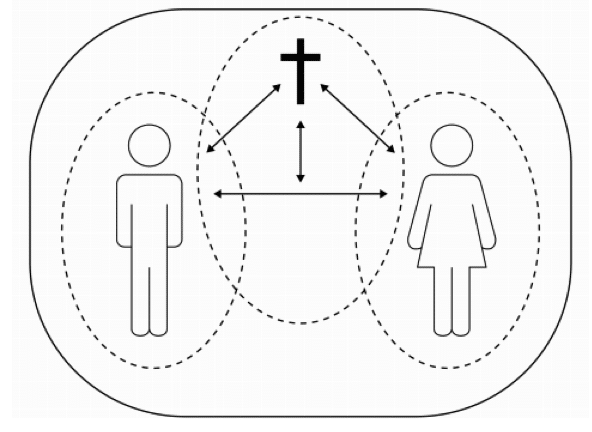Candles and Confusion
We’ve seen couples acting out the unity candle ritual in many of the weddings we’ve attended over the years. Sometimes the symbolism of the man and woman blowing out their individual candles is used for illustrative comments from the pulpit, such as, “Today, these two people are no longer two individual lives, but one flesh united in holy matrimony before God and these witnesses.”
It’s a beautiful ritual, but it drives us completely nuts! When we see the individual candles being blown out, we want to scream (but that would probably upset the bride, the groom, and the wedding guests). We want to pull out our hair (but that would bother the church janitors).
The main thing we want to do is rush to the altar and offer the bride and groom special discounts on our Marriage Intensives. They’re probably going to need our help down the road because the beautiful unity candle ritual conceals a dangerous theological misunderstanding that can actually hinder these two lovers from achieving the unity and oneness they desire.
The problem happens at the very end of the ritual when the bride and groom blow out their individual candles. This symbolism strongly suggests that once these two individuals become one in marriage, they must suddenly cease being the two individuals they were before. It sends this message: I no longer exist as an individual, but now my individuality and personality should be surrendered as we pursue the higher calling of becoming “one.”
Nobody’s sure exactly where the whole unity candle trend started. Most trace its rise to the 1981 wedding of Luke and Laura on the popular daytime TV soap opera General Hospital. Others say the whole trend took off because of creative candle merchants.
Marriage: True Unity
We would be absolutely fine if couples who light unity candles in their weddings could make one small but significant change to the ritual. Please, people, keep your two individual candles burning bright! This would send a much better message: We are joining together in marriage to experience the unity and oneness marriage can bring, but the two of us are not obliterating our God-given individual existence or calling.
Jesus’ teaching on marriage describes oneness as unity: “So they are no longer two but one flesh. What therefore God has joined together, let not man separate” (Matthew 19:6; see also Mark 10:1-8; 1 Corinthians 6:16; Ephesians 5:22-33). This Matthew verse uses the metaphor of “one flesh” to describe the spiritual, emotional, and physical unity we can experience only in marriage. But this metaphorical language should not be taken literally. That would be ridiculous.
The 3 Marriage Essentials
Most couples we talk to begin their marriages without any clear perspective of what they’re really trying to accomplish together, or how to get there. However, we know that having a good perspective on the relational playing field and a sound marital strategy will always yield the best results.
In the game of marriage, we also have an Enemy who has his own perspective and game plan. If Satan can get men and women confused about God’s design for marriage, they’re more likely to build their union on faulty foundations. That’s exactly what we see happening with many of the couples we serve.
Successful marriages are those marriages where each of these three components is nurtured and cared for. Instead of doing away with our individual personalities as the unity candle suggests, a godly marriage flourishes when both the man and woman are healthy, flourishing, and burning bright!
In our work with troubled couples, we often find a flawed view of marriage, exemplified by the unity candle, underneath all the confusion and division. The unity candle ritual falsely says that “1 + 1 = 1.” The fact is, there are three essential components in every marriage:
- Man
- Woman
- Relationship
1 + 1 = 3 Model
Finally, here’s a model that’s robust and realistic. The essential elements are all here, including:
- two healthy adults,
- each of whom has a relationship with himself or herself,
- and each of whom has a close relationship with Christ, who is their sustainer.
- The two adults meet and develop a relationship, indicated by the shared Interactive Space between them that consists of meaningful communication, time together, fun and laughter, managing conflict in a healthy way, sexual intimacy, and a shared spiritual relationship (safety);
- they marry, creating a Covenant Marriage Boundary around their relationship (security);
- and Christ is present and active in this healthy relationship.

Both partners are committed to being healthy adults in the four areas: physical, mental, spiritual, and emotional. And both are committed to doing their part to actively deepen and strengthen their shared Interactive Space so that both enjoy and feel safe within this center circle.
These two flawed and imperfect people are on a journey of marital love. They’re more fully becoming who they were created to be, different by design; they are knowing and being known; they love, care for, and support each other. This is intimacy at its best! The two have become one in spirit and purpose, but there’s so much more going on.
The details may escape you, but remember these three essential components in every marriage:
- Man
- Woman
- Relationship
When all three are healthy, you and your spouse will experience the joy and beauty of marriage as God designed it.
Get the Book
Taken from 9 Lies That Will Destroy Your Marriage by Robert Paul and Greg Smalley. Copyright © 2020. Used by permission of Focus on the Family. All rights reserved. Represented by Tyndale House Publishers, a Division of Tyndale House Ministries.
Robert “Bob” Paul has a master’s degree, a diploma in Christian counseling, and an honorary doctorate from Psychological Studies Institute. He is vice president of the Focus on the Family Marriage Institute and a licensed professional counselor.
Dr. Greg Smalley has a doctorate in psychology (PsyD) and is vice president of marriage and family formation for Focus on the Family.











